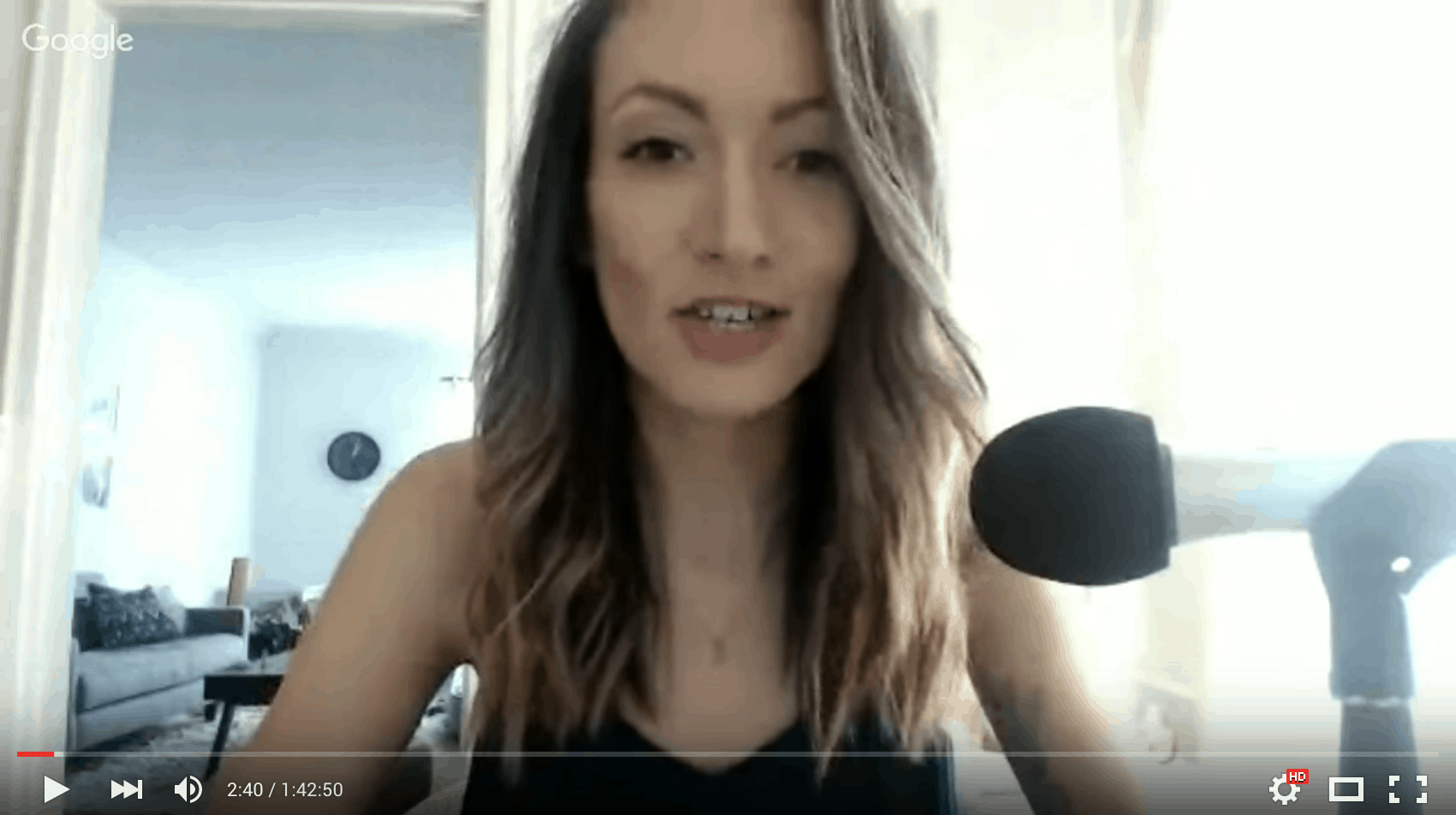Hooooly moly. I think I just took the longest blogging hiatus of my life. Thanks for not attacking me with virtual pitchforks or anything, you guys are the best. 😉

Lately, I’ve been focusing on teaching people how to utilize their email lists because I know that a person’s email list is one of their biggest assets…and I want you to see that, too! I’ve also seen the swift change that growing and nurturing my own list has had on my business. An active email list is often the cure to many business and blogging woes.
No one’s reading your blog posts? Use your email list to create more engagement.
No one’s buying your products? Use an email sequence.
Want to build a stronger brand? Share tons of value with your email subscribers.
Your list is kind of your holy grail of business tools. Not only will it increase engagement and a sense of community, but it will also help you increase sales. Now, of course, you can’t just send a half-hearted email and expect the community and cash to roll right in. No. You need to be a little more savvy, strategic, and value-centered to achieve the results you’re aiming for.
In today’s post, we’re talking about six different ways that you can use your email list to bring home the bacon (do people still say that?). So, if you want to increase your sales, help people see your value, and build a stronger business, then I hope you’re ready to party. Let’s do this.
First of all, I’ve got a little cheatsheet to help you implement some of the things we’re about to talk about in this post. Just click the button below to grab it. It’s free, yo.
1. Hone in on your niche and ideal customers
Dude. If you want to start a profitable business, you need to pick a niche. I know, I know. I can see your pitchforks and torches already. Don’t hate me, k? I just want you to succeed, that’s all. If you’re unconvinced, then read this post about selecting a focus (and why it’s muy importante).
In terms of creating an online business, you’ll be stunting your growth dramatically if you try to please everyone or talk about too many subjects. I’m not being a hater, I actually speak from experience! During the first year or two of my blog’s life, I experimented with tons of topics. Self development. Creativity. Fashion in Japan (?!?!). And I’ll admit, I was able to grow a devoted little audience while talking about a zillion different things. But one day I decided to start talking more and more about business and pro blogging.
And BAM.
It was like my email list, traffic, and income had a private meeting where they decided to start giving a crap. “We’re stoked that you finally picked a niche, so we’re just going to rock out over here for the rest of eternity. Cool?”
Aside from making it easier to grow your business with a more specific niche, you’re also making it easier for people to want to sign up for your list. Without a niche, your audience may be wondering why they should sign up for your list in the first place or what you would even send them.
One word of caution: while selecting your niche, make sure you’re focusing on your ideal customers or clients, not your peers. The mistake I see a lot of people make is that they create blog posts and content that are directed toward people just like them, rather than the people that they want to attract and can sell their products to.
Bottom line: Pick a niche. Be free.
2. Value value value pitch
Actually, it should probably be more like value value value value value value value value pitch.
The people who do not make much revenue through their email lists are the ones who send emails that go a little something like this:
Subject line: Announcing my new super awesome product!
Email: Hey subscriber! I just created this new super awesome product that I think you would like! Here’s the sales page! Go buy it!
Okay, so maaaaybe more people aren’t quite that blatant, but they’re saying the same thing, just in a few more words. Rather than simply telling people to go buy your product, you need to convince people that your product is right for them in the first place. Many people will see your product and barely give it a second glance, simply because they don’t know how it will benefit them and because they don’t know how you will benefit them. How can they understand your worth and knowledge if all you do is tell them to buy your crap?
Instead, use your email list as almost…a second blog. Send vulnerable emails that inspire your audience. Give them new tips and strategies you’ve never mentioned elsewhere. Tell them about an upcoming workshop you’re teaching fo’ free. Give them a free workbook or cheatsheet, just because.
Basically, you want your subscribers to look forward to opening your emails because they know they’ll always get something good out of them. So, send free downloads, free knowledge, and free inspiration well before you ask them to open their wallets.
3. Create clear paths for your business
Here’s a secret: most online entrepreneurs don’t publish blog posts or other content just for the heck of it. They might do that sometimes, especially when they’re just getting started, but typically if they are writing a blog post, it’s the entrance point for a specific path.
Let me explain.
Like we talked about in #2 above, giving value is insanely important if you want to build a business that people care about. Also, many people in your audience are probably not on your email list yet, but they do read your blog or consume your content. So, the best thing to do is to create a path, starting on the outskirts of your brand (like your blog or social media) and leading them to the inner circle. Like this:

So, the idea is to write a blog post or create a piece of content about your product’s topic. This is not simply to talk about your product. This is primarily meant to provide value to your audience. Then, use an opt-in incentive in order to encourage them to sign up for your email list. An opt-in incentive is something you give away for free, in addition to your blog post. It could be a worksheet, cheatsheet, ebook, etc. Now that they’re on your email list, you could invite them to a related webinar or pitch your product. Here’s what this process looks like:

As you can see, every piece of content you produce now has a purpose. You’re sharing value with your audience by producing killer content, so the people who might be interested in your product will sign up for your list and get to hear more about your related, paid offering.
The reason why you wouldn’t just create a blog post or piece of content introducing your new product is because, like we talked about in point #2 above, people need to trust you and feel like you’re knowledgeable before they will buy from you.
4. Use it to rock your webinars
Here’s the difference between promoting something on your blog, social media, and to your email list: in order to see a promotion on your blog or social media, someone would have to go to your blog or social media. They don’t get a notification. That puts a lot of weight on your audience to check your accounts regularly or happen to see your Instagram post in a feed of others, which they simply will not do.
On the other hand, if you send someone an email, then you can be pretty darn certain that they will see it. People check their email several times a day, but they may not check social media at the specific time you publish your social media post. And they may not visit your blog because then they’d have to type your link into their browser and who in the world is going to remember to do that, especially at the specific time you need to reach them? Nah, bro.
This is a big reason why an email list is vital. It allows you to reach your audience effectively and when you want to, which is especially important for time-sensitive offerings, like launches or webinars.

So, whenever you’re planning a new webinar, your email list should be the first place you send the registration page to. Not only will you get more sign-ups for your webinar (where you can pitch and sell your product), simply because you’re reaching your subscribers in their inbox (which they check frequently), but you’re also giving free value to your subscribers (a 60 minute class?! Heck yeah!). Sometimes, when I’m busy (or lazy, let’s be real here), I don’t even promote my webinars on social media. I only send them to my email subscribers. That’s how valuable your list is!
**Disclaimer: While I do think your email list is crazy important, I don’t think that social media is unimportant. Some people will tell you that social media is a waste of time, and you’re welcome to believe whoever you want, but I actually think social media is a phenomenal place to build your authority, be personable, and grow an engaged community around your brand. But for making sales and reaching your audience with time sensitive offers? Your email list is the way to go.
5. Use a sales funnel
If you want to make sales of your products through your email list, then a sales funnel or email sequence is the way to go. I feel like some of these terms, like “sales funnel,” get a bad rap because certain online marketers over the years have been really spammy or pushy in their emails. But in reality, a sales funnel is just a chain of emails that tell people about your products or services. You probably get them everyday without even realizing it, from online business owners to Taco Bell.
There are nearly endless ways for you to create a sales funnel, but the main gist is to provide value, while showing people why your product can benefit them. Think of your sales funnel as a sales page spread out over several emails. On a sales page, you don’t just slap a “buy now” button onto it and expect people to buy your thing. You first need to help them go through necessary mindset shifts and show them why your thing will help them with whatever problem they’re having.
The same thing goes for your sales funnel, so try breaking it down into the different sections of your sales page. One email may be about breaking down the stereotypes or myths they believe about your topic. Another email may talk about your personal turning point or the results you’ve seen with your strategies. Another email may share a case study from one of your clients or students. Even though these emails are selling your products, your main objective is to provide value to your subscribers, so you should position your sales funnel emails to make sure they are still useful, even for people who never buy.
For example, if you’re sending a case study about the incredible results you got for one of your students, you could position it as something like “Check out how Miranda lost 23 pounds in 3 months (with strategies you can use!).” Then, your email would talk about Miranda’s success story, but will also tell people what Miranda did to achieve such success. So, you’re giving people actionable tips they can use. Finally, you’ll let people know that if they want to kick up their own weight loss regime, your e-course/personal training/coaching/whatever is designed to help people achieve the kinds of results Miranda did. So, even when you’re “pitching,” you’re being useful.
Of course, you’ll want to add some “straight value” emails into your sales funnel, too. In these emails, you’re essentially just providing new tips and advice for people who are interested in your product’s topic. This will remind people of your vast knowledge of this topic and also help them with the problem they’re having.
How do you get someone into your sales funnel? Typically, they’ll “enter” it by opting in to receive some sort of freebie or content upgrade on your website. After they opt-in for that freebie, they’ll receive a “tag” in your email service provider (ESP). Then, you’ll make sure that you have set up your ESP so that anyone with that tag automatically receives your sales funnel sequence. Now, you’ll be able to sell your products and services on autopilot!
For a simple (and free!) sales funnel cheatsheet, just click the image below and it will be emailed to you right away.
6. Use a tripwire
I don’t really like the word “tripwire” because it sounds kind of aggressive and evil, but hey I don’t invent the words over here, I just tell you about them. 😉 Anywho, a tripwire is an inexpensive offer you pitch to someone immediately after they sign up for your list. Usually it costs $7 or $9. Cheap-o.
The reasoning behind doing this is that, psychologically, someone is more likely to remember you and buy from you again than they are likely to become a customer in the first place. So, if the first offer they see from you is something really valuable for only 7 bucks, then they are likely to purchase it, turning them into a customer right away. Think about it: Are you more likely to open someone’s future emails if you’ve already purchased one of their products (which was uber helpful and awesome) or are you more likely to open someone’s emails who you’ve never really interacted with before? Bingo.
Also, when you pitch them your higher-priced offerings in the future, they’ll already be a customer of yours (more likely to buy again), so they’ll have had the chance to see what your paid stuff is like. Kind of like a teaser into your paid products and services.
Most people who use tripwires also put tripwire buyers into special email sequences, which provide value, thank them for their purchase, and eventually pitch one of your more expensive offerings. Think of it this way: many coaches offer free “discovery calls” to help potential clients get acquainted with them, which is likely to lead to more sales of their coaching services. Tripwires are similar. An inexpensive way to get to know you as well as to get to know the kind of value you bring to the table, which will increase the number of buyers of your premium products.
In order to set up a tripwire, you will need to create a product that you can sell for $7 or $9. Even though it’s cheap, it should still be very valuable! Then, create a sales page for that product and a way for people to pay for it (you could easily do this in Teachable). Lastly, you need to set up your opt-in form or landing page so that after someone subscribes, they are sent to the tripwire sales page. The sales page should start with something like, “Check your email to confirm your subscription. While you’re waiting, check THIS out…” And then it will go into the sales page for your tripwire offer.
The key to tripwires is to have a plan for after someone buys it. Will they get an email sequence that tells them about one of your larger products? Will you reach out to them individually to say hello and see if they want to schedule a free discovery call? Have a plan, otherwise your tripwire is basically just a $7 product with no path (as we talked about in #3!).
Woo! You freakin’ rock for making it to the end. As a free little bonus, I put together a cheatsheet that you can download, which includes exactly what to include in a basic sales funnel for your business (including the different emails to write). Click here or the image below to download it!
If you found this blog post helpful, go ahead and pin the image below to share it with your friends!




















